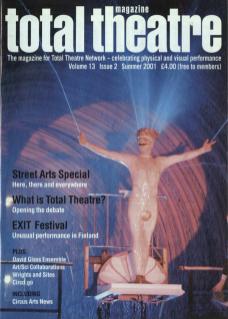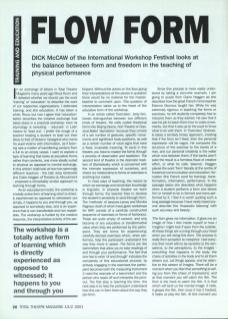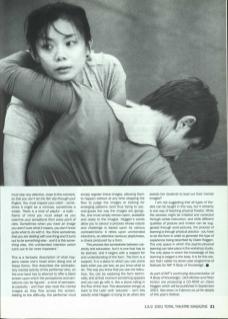In an exchange of letters in Total Theatre Magazine many years ago Rivca Ruvin and I debated whether we should use the word 'training' or 'education' to describe the work of our respective organisations. I defended training, and she education. It has taken a while, Rivca, but now I agree that education better describes the creative exchange that takes place in a practical workshop: even its etymology is revealing – 'educare' in Latin means to 'lead out'. I prefer the image of a teacher helping a student to lead out their ideas to that of Dickens' Gradgrind who crams his pupil-victims with information, as if learning was a matter of transferring content from a full to an empty vessel. I want to explore a type of learning that looks at educative forms rather than contents, one more ideally suited to physical as opposed to mental exchange. In this article I shall look at how two seemingly different teachers – the late Jerzy Grotowski and Claire Heggen of Théâtre du Mouvement – proposed a remarkably similar approach to learning through forms.
As an educational model, the workshop is a totally active form of learning which is directly experienced as opposed to witnessed: put simply, it happens to you and through you, as opposed to somebody else, and is an experience that is non-transferable and non-repeatable. The workshop is fuelled by the creative response, the interpretative activity of the participant. Without the actors on the floor giving their interpretations of the pieces in question there would be no material for the master-teacher to comment upon. This question of interpretation takes us to the heart of the educative form of the workshop.
In an article called 'Exercises', Jerzy Grotowski distinguishes between two different kinds of theatre. He calls coded theatrical forms like Beijing Opera, Noh Theatre or Classical Ballet 'alphabetic' because they consist of a set number of gestures, specific movements and significant body-positions, as well as a certain number of vocal signs that have a fixed, invariable meaning. To excel in this theatre, you have to master the forms through a process of observation and repetition. The second kind of theatre is the dramatic tradition of Stanislavsky which is concerned with the intimate expression of ourselves, and where our relationship to forms or exercises is anything but coded.
In most ways of teaching, the means by which we exchange and remember knowledge is linguistic. In physical theatre we learn through forms; the teacher tries to develop the student's sensitivity to (and through) form. The methods of Jacques Lecoq and Monika Pagneux (both of whom have given workshops for IWF) consist of a carefully constructed sequence of exercises or forms of behaviour. These are quite empty of content, and only become of any educative or transformative value when they are performed by the participant. They are forms for experiencing carefully devised exercises which, when performed, help the participant understand the way they move in space. The forms are like barometers that allow you to take readings of and through your performance. The fact that one has to write 'of and through’ indicates the complexity of this educational process: by actively engaging in the exercises the participant becomes both the measuring instrument (I used the example of a barometer) and the person who reads off and interprets the printout. The first step is teaching the form, the next step is to help the participant understand how this can in-form them about the way they per-form.
The workshop is a totally active form of learning which is directly experienced as opposed to witnessed; it happens to you and through you
Since this process is more easily understood by taking a concrete example, I am going to quote from Claire Heggen as she describes how the great French mime teacher Étienne Decroux taught her. While he was extremely rigorous in teaching the forms or exercises, he left students completely free to interpret them as they wished. He saw that it was his job to teach them how to make movements, but that it was up to the pupil to know what to do with them. In 'Exercises', Grotowski takes a similarly binary approach, insisting that if the form isn't fixed, then the personal expression will be vague. He compares the structure of the exercise to the banks of a river, and our personal creativity is the water which runs between them: if the banks aren't solid the result is a formless flood of creative effort, or what he calls 'plasma'. Heggen places the word ‘form' literally at the centre of theatrical communication and education: formation (the French word for training, transformation, information, performance). In the passage below she describes what happens when a student performs a form and allows him or herself to be in-formed and trans-performed by it. I feel it is worth quoting such a long passage because I have rarely heard any one describe this rhapsodic listening with such accuracy and beauty:
‘The form gives me information. It gives me an image of how I feel inside myself or how I imagine I might look if seen from the outside. All these things are running through your head when you are doing this form. The process is really from sensation to metaphor. I ask everyone that I work with to be sensitive to the sensations, to the perceptions, to the images – everything that happens in the body, the chaos of activities in the body and to let them stream out. Let things appear, and be attentive to this stream of images. There will be a moment when you feel that something is calling you from this chaos of impressions, and at that moment you will catch the fish. The form is the hook to catch the fish. It is that which will land us the mental image. It calls, it grasps the fish, then once it has it hooked, it helps us play the fish. At this moment you must stay very attentive, close to the moment, so that you don't let the fish slip through your fingers. You must inspect your catch – sometimes it might be a minnow, sometimes a whale. There is a kind of playful – a ludic – frame of mind you must adopt as you examine your sensations from every point of view. Sometimes when you have an image you aren't sure what it means, you don't know quite what to do with it. You think sometimes that you are dealing with one thing and it turns out to be something else – and it is this something else, this unintended intention which turns out to be more important.’
This is a fantastic description of what happens inside one's head when doing one of these forms. She describes the contradictory mental activity of the performer who, on the one hand has to attempt to offer a blank screen upon which the perceptions and sensations can be figured – a kind of perceptual passivity – and then also read the mental images as they flow across the screen. Adding to the difficulty, the performer must simply register these images, allowing them to happen without at any time stopping the flow to judge the images or looking for emerging patterns (and thus trying to second-guess the way the images are going). No, one must simply remain open, available and ready to the images. Heggen's words allow you to savour a process whose nature and challenge is based upon its various contradictions: it relies upon unintended intentions, an attentive (serious) playfulness, a chaos produced by a form.
This process lies somewhere between creativity and education, but it is one that has to be learned, and it begins with a respect for and understanding of the form. The form is a support. It is a place to which you can come back when you are lost, so you know what to do. This way you know that you are not ridiculous. You can be exploring the form technically, and at that moment something appears and you can go with it, like a stone rolling in the flow of the river. This description brings us back to the Latin verb 'educare' – isn't this exactly what Heggen is trying to do when she assists her students to lead out their mental images?
I am not suggesting that all types of theatre can be taught in this way, but it certainly is one way of teaching physical theatre. While the process might be initiated and corrected through verbal instruction, and while different qualities of posture and motion can be suggested through word-pictures, the process of learning is through physical practice – you have to do the form in order to generate the type of experience being described by Claire Heggen. The only space in which this psycho-physical learning can take place is the workshop studio. The only place in which the knowledge of this learning is lodged is the body. It is for this reason that I called my seven-year programme of festivals for IWF ‘A Body of Knowledge’.
As part of IWF's continuing documentation of A Body of Knowledge, Dick McCaw and Peter Hulton are producing a CD-ROM on Claire Heggen which will be published in September 2001. See www.i-w-f.demon.co.uk for details of this year's festival.


